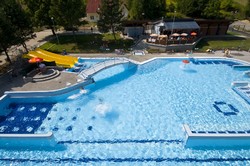Pool
 Pools represent a very tough application in the field of insulation and installation of ceramic tiles due the ongoing exposure to pressurised water and regular sanitation. The solution always requires a professional assessment and professional design documentation. In pools, we place very stringent requirements on the base structures where we strongly recommend the use of waterproof concrete.
Pools represent a very tough application in the field of insulation and installation of ceramic tiles due the ongoing exposure to pressurised water and regular sanitation. The solution always requires a professional assessment and professional design documentation. In pools, we place very stringent requirements on the base structures where we strongly recommend the use of waterproof concrete.
Types of structure
- PE 201, PE 202 Primer
- SE 6 waterproofing slurry with a min. thickness of 3 mm
- SE 5 sealing tape with a min. width of 100 mm
- AD 530 OR AD 550 adhesive
- Pool tiles (COLOR TWO or POOL series)
- GE EASY epoxy jointing material
- SI silicone sealant + PES polyethylene separator
Work procedure – detailed description
Preparation: The base must fulfil the requirements specified by the design documentation and relevant standards. It must be cured with a residual humidity of up to 4%. The tensile strength value must be at least 1.5 MPa. Deviation of the base flatness must not exceed 2 mm per 2 m of the bar. In the event of any shortcomings in this area, the surface must be levelled with LE 21 levelling screed with the addition of a 1 – 15mm layer of EM 10 refining emulsion or MO 50 correction material with a thickness of 2-35 mm. For quick localized repairs, MO 35 Quick may be used. The surface of the repaired concrete must always be primed with PE 201 or PE 202.
Insulation – perfect sealing of the pool including the adjacent gutters and walkways: The insulation is applied with SE 6 screed in three layers with a total thickness of 3 mm and a width of approx. 4.5 kg per m2. The product creates a permanent elastic insulation layer resistant to the pressure created by the water. The interval between applying each individual layer is approx. 4-6 hours. For bridging any transitions and joints, and for reinforcing the internal corners, SE 5 gauze is inserted in the insulating layer. The gauze must be attached across the entire surface of the SE 6. For full contact, approx. 0.3 kg/bm is needed. Specific passage points are sealed with SAB elastic polyurethane sealant without any base coat applied. The structural design used for these features is based on detailed designs or consultations with our technical advisors.
Sealing check prior to undertaking further work due to the possible need to repair leaks – flood test: The entire insulation system is only ready for the flood test after it has fully cured, i.e. after 7 days. When the express SE mach3 insulation material is used, the entire curing process for the insulation system will be reduced to a mere 3 days!!!
Installation of ceramic tiles on insulation screed: Various types of adhesive sealants may be used for attaching pool tiles. Maximum caution must be exercised at all times as repairs carried out during installation directly on the insulation layer involve a great deal of risk. We always apply the buttering-floating method in order to ensure no cavities develop between the tile/base, and we always keep the expansion joint fields free. For standard pool programme formats, we use C2TE S1 grade AD 530 cement adhesive. For smaller formats and mosaics, we use C2TE S1 grade white AD 550 adhesive. We recommend for non-ceramic tiles be attached directly with the GE epoxy system. Between 2.5 and 5 kg/m2 is typically needed.
Jointing of the ceramic shell with a product chemically resistant to disinfectants used for operation of the pool: RG grade GE EASY epoxy-based jointing material is used for the jointing and is supplied in seven different colours. The improved formula of this material exhibits markedly improved washing characteristics after jointing!!! The adhesive must be cured and the joint clean and dry. Approx. 1 - 1.8 kg/ m2 is needed, depending on the format size of the tiles.
Resealing joints in passageways and transitions with permanent elastic sealant: In order to allow movement in the expansion joint, SI sanitary silicone with an adhesive Primer NP base coat must be applied to non-absorbent bases. The spreading rate of the 310 ml cartridge is approx. 5-12 mb, depending on the size of the joint. Between 8-20 ml/mb is needed for the base coat, depending on absorbency and shape of the joint. The colour range covers all colours of the GE EASY product. If SI silicone is applied, the PES polyethylene separator must be used. It will prevent undesired adhesion to the bottom of the joint and define the exact shape of the silicone.
Cleaning & Maintenance
For regular maintenance, use the CL 803 cleaning agent combined with CL 802 (scale) and CL 810 (grease). A cleaning plan must be created for the premises. Poor cleaning leads to impurities building up, which deteriorates slip protection properties.







